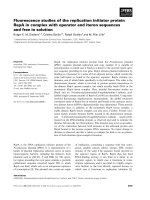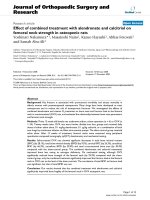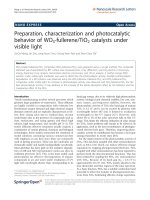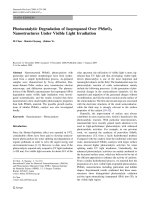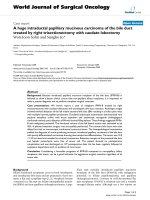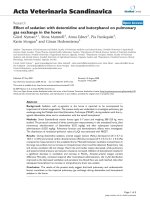Enhance the activity of the photocatalyst TiO2-P25 degussa by doping it with N and Mg on degradation of phenol under visible light
Bạn đang xem bản rút gọn của tài liệu. Xem và tải ngay bản đầy đủ của tài liệu tại đây (2.01 MB, 10 trang )
An Giang University Journal of Science – 2019, Vol. 6, 60 – 69
ENHANCE THE ACTIVITY OF THE PHOTOCATALYST TiO2-P25 DEGUSSA
BY DOPING IT WITH N AND Mg ON DEGRADATION OF PHENOL
UNDER VISIBLE LIGHT
Pham Phat Tan1
An Giang University
1
Information:
Received: 31/05/2018
Accepted: 29/09/2018
Published: 02/2019
Keywords:
Photocatalyst, N-Mg co-doped
TiO2, phenol, degradation
ABSTRACT
Catalyst TiO2 with N-doped, Mg-doped and N-Mg co-doped were created by
impregnation method with Mg(NO3)2 (add Mg in) and mix method with urea
(add N in). The XRD, SEM, DR, BET, FT-IR measurements were carried out
for structural characterization of the TiO2 samples. The result performed,
compared with the sample of initial TiO2-P25 particle size and specific
surface area, samples of doped-catalyst changed insignificantly. The average
crystalline size was 30-32 nm, specific surface area about 50 - 60 m2/g. The
crystalline phase components did not change, including only anatase and
rutile. Doped-catalyst samples narrowed the band gap of TiO2 (values of Eg
decreased to under 3.0 eV). In there, N-doped sample possessed the lowest
value of Eg (Eg = 2.53 eV), it meant this sample responded to the visible
light area obviously. In the degradation of phenol, N-Mg co-doped TiO2 had
better catalytic performance than N-doped and Mg-doped alone. The order
of doping elements (N and Mg) shown to be an important factor on the
catalytic activity of the doping catalysts. The catalysts TiO2 were doped by N
first then Mg demonstrated synergic effect and activity of the catalysts
increased 1.5- 1.6 times compared with pure TiO2. By contrast, in the reverse
order (first Mg then N) the inhibited effect was observed and the catalytic
activity would decrease.
1. INTRODUCTION
study with the aim of seeking for photocatalyst of
TiO2, which is highly active when using solar
energy in two directions, is indispensable, which
contributes in applying the treatment of
biodegradable organic pollutants with "green"
technology.
TiO2-based photocatalysis is one of the advanced
oxidation processes due to the high catalytic
activity of TiO2 in the presence of UV light. It still
has some limitations, however, needed to be
resolved. For instance, (i) narrowing Eg (the band
gap) will allow the use of extensible optical
performance beyond the ultraviolet to the visible
range (UV-VIS) of solar energy patterns; (ii)
preventing the recombination of e-CB and h+VB of
the TiO2 after the influence of the photon. The
If non-metallic elements are implanted such as N,
S, F, I, C ... into TiO2 so that they replace partially
the position of O in TiO2 crystal lattice, this will
narrow the band gap of TiO2 to lower level, for
example, Eg = 2.54 – 2.66 eV then TiO2
60
An Giang University Journal of Science – 2019, Vol. 6, 60 – 69
photocatalyst activity will be promoted
throughout the UV-VIS range of solar energy
(Asahi, 2001; Ihara, 2003; Mozia, 2005).
of given concentration in such a way as to Mg
content in the catalyst reached 1.0%. The mixture
was stirred for two hours, then stabilized for 24
hours. Drying a sample at 110 oC for three hours
and heated at 450 oC for three hours. (Denoted as
TiO2-1Mg). The magnesium content above is
optimal, and this was published before. In that
study, TiO2 Degussa P25 catalyst containing Mg
with different content (0.5 -10%) was prepared by
an
impregnating
method
and
showed
photocatalytic activity increased when Mg content
was in 0.5-1% and peaked when Mg content
reached 1%, then gradually decreased when Mg
content was higher than 1% in the decomposition
reaction of phenol with UV-VIS light. (P.P. Tân,
2017)
The second direction is to decelerate
recombination of pairs of photo-generated
electron on conductor band and photo-generated
hole on the valence band of TiO2 to create many
free radicals *OH – an extremely strong oxidizing
agent plays a pivotal role in the oxidation of
organic contaminants (Colmenares, 2006). This
direction is conducted by doping TiO2 with metal
elements: Cu, Ag, Fe, Ni, Pt, Pd, Zn, Zr, Cr, W,
Ru ... (Bandara, 2004; Barakat, 2005; Iliev, 2006;
Vaidya, 2004; Wang, 2004; Xu, 2004; Zhang,
2004) to create electron capturing centers on
conductor band to prevent photo-generated
electrons return valence band, then reduce
recombination e-CB và h+VB.
TiO2-P25 Degussa powder were mixed with urea
with molar ratios 1:1, calcinated at 4000C, for two
hours in the air with gradient 50C/minute.
(denoted as TiO2-1U). The ratio above is optimal
and was published before. (P.P. Tân, 2008)
Besides, the tendency of research metal-nonmetal
co-doped TiO2 has been especially notified, and
there were studies on metal-nonmetal co-doped
TiO2 (Huang, 2007; Morikawa, 2006; Pan, 2006;
Wei, 2004). The result increased the catalyst
activity but some studies reflected reverse results.
The catalysts TiO2 contained both N and Mg
(TiO2-N-Mg) were prepared in different order.
TiO2-1Mg powders were mixed with urea with
molar ratios 1:1, calcinated at 4000C for two hours
(denoted as TiO2-1Mg-1U). TiO2-1U powders
were impregnated in Mg(NO3)2 solution with
magnesium content at 1%, calcinated at 4500C for
three hours (denoted as TiO2-1U-1Mg).
Nowadays, very few studies in using magnesium
and nitrogen concurrently to dop TiO2 are
published and this considered as an interesting
and promising study. On the basis of science,
doping TiO2 with a specific element with certain
content to increase activity, however if co-doping
with both elements happens, their activity may
increase due to synergic effect among the roles of
nitrogen and magnesium, but may decrease their
activity due to inhibition among these factors.
This article, the photocatalysts N, Mg – co-doped
TiO2 were prepared to degrade phenol under
visible light.
The catalysts were finely pulverized before
surveying physical-chemical characteristics and
their activity. Compared samples were carried out
similarly but without the Mg(NO3)2.
2.2 Reactor and light source
The activity of doped TiO2 catalysts was surveyed
on the reaction system discontinuously pyrex
glass, with 150 ml volume, 160 mm high, 42 mm
of diameter. A 150W halogen light (OSRAM
HLX) possesses wavelengths from 360 nm to 830
nm was placed in a cylinder of quartz and was
cooled by the surrounding water.
2. EXPERIMENTS
2.1 TiO2-P25 modification with N, Mg
TiO2-P25 Degussa powder (anatase ≈ 80%, rutile
≈ 20%, BET surface area ≈ 50 m2/g, particle size
≈ 30 nm) was impregnated by Mg(NO3)2 solution
Reactant is phenol concentration of 50mg/l.
61
An Giang University Journal of Science – 2019, Vol. 6, 60 – 69
2.3 Process and analytical methods
α phenol ( % ) =
The catalyst samples were analyzed on their
structure and physical-chemical characteristics by
methods such as X-ray diffraction (XRD) - the
sample was measured on XRD instrument
(SIEMENS - Germany) with CuKα anode
electrode (1,5406 A0), 2θ scanning angle from 15o
to 70o; method of scanning electron microscopy
(SEM) was done on SEM instrument (JOEL-JSM5500-Japan). The BET surface area measurement
was performed on the CHEMBET 3000.
Co − Ct
.100
Co
In there, C0: initial concentration of phenol, Ct:
concentration of phenol at time t, α: the
conversion of phenol at time t.
Total Organic Carbon (TOC) measurements were
performed using ANATOC II by direct injection
of the samples. Results of the total initial organic
carbon and sample of corresponding reactants at
time t were analyzed automatically. The
mineralization of the samples were calculated:
The diffuse reflection spectra was measured on
DRS (JASCO V-550-Japan). The Eg values were
calculated by Eg = hC/λ = 1239,8/λ (eV)
βTOC ( % ) =
The activity of catalysts was assessed by the
conversion and mineralization of phenol. The
concentration of phenol in the reaction time was
determined in the characteristic absorption peaks:
211 and 270 nm (measured on UV-VIS Jasco
V530 machine, Japan, mineralization was
determined on ANATOC II, Australia). The
calculation formula was as follows:
TOCo − TOCt
.100
TOCo
In there, TOC0, TOCt: total initial organic carbon
and sample of corresponding reactants at time t, β:
the mineralization.
3. RESULTS AND DISCUSSION
3.1 Research on the structure of the prepared
catalysts
Physical-chemical characteristics of the catalysts
are shown in Table 1.
Table 1. Physical-chemical features of TiO2-P25 and doped-TiO2 catalysts.
Catalyst Sample
SBET
(m2/g)
Average particle size (nm)
Color
TiO2-P25
50
30
White
TiO2-1Mg
50
30
White
TiO2-1U
60
30-32
Yellow
TiO2-1Mg-1U
59
30-32
Light yellow
TiO2-1U-1Mg
59
30-32
Ivory white
The result from Table 1 showed that with N, Mg
alone or concurrently at TiO2-P25 did not change
significantly the specific surface compared with
TiO2-P25 pure, the specific surface fluctuates in
the range of 50-60 m2/g. This indicated, the
doping TiO2-P25 pure with two elements above
with 1% Mg content or catalyst and urea with
molar ratios 1:1 or doping with both N and Mg
did not change significantly their specific surface
area though N was added first then Mg or in
reverse order. The calculated results from XRD
patterns (Figure 1) performed the samples above
had stable particle sizes within the range of 30 –
32 nm.
62
An Giang University Journal of Science – 2019, Vol. 6, 60 – 69
5
4
3
2
2
1
3
4
5
6
Figure 1. XRD patterns of TiO2-P25 catalyst samples: (1) TiO2-P25,
(2) TiO2-1Mg, (3) TiO2-1U, (4) TiO2-1U-1Mg và (5) TiO2-1Mg-1U
The XRD patterns showed that catalyst which
were doped with N or Mg or two elements above
had crystalline phase components and they were
similar to the original TiO2-P25. All samples
appeared specific peaks of anatase phase (2θ =
25.3; 37.8; 48.1) and rutile phase (2θ = 27.5; 36.1;
54.4), to doped samples, there was no any new
peak.
TiO2-
TiO2-
TiO2-1U-
TiO2-1U
TiO2-1MgFigure 2: The SEM image of the catalysts:
TiO2-P25 and doped-TiO2
63
An Giang University Journal of Science – 2019, Vol. 6, 60 – 69
Figure 3. The SEM image of the catalyst Mg doped TiO2-P25
TiO2-1U-1Mg
TiO2-1U
Figure 4. The TEM image of the catalysts: TiO2-1U và TiO2-1U-1Mg
450 0C. In Figure 3, the elements were distributed
equally on the surface of the catalyst. TEM
images (Figure 4) of the catalysts showed the
particle size of doped-catalysts changed
insignificantly (about 30-32 nm).
The SEM images (Figure 2) indicated that the
catalysts have the same shape and distribution.
This demonstrated that there was no clumped
phenomenon of the crystal lattice in TiO2 catalyst
samples despite doping with element alone or codoping with N and Mg when being calcinated at
64
An Giang University Journal of Science – 2019, Vol. 6, 60 – 69
Therefore, doping TiO2-P25 with qualitative and
quantitative components and doping condition as
mentioned above, particularly, when co-doping
with N first then Mg or in reverse order happened,
physical properties and catalyst structure had
same results. This is an advantageous point to
study their activity later.
3.2 Order of adding N and Mg in TiO2-P25 photocatalyst
Figure 5. The DRS partterns of the catalysts: TiO2-P25 and doped-TiO2
The DRS patterns (Figure 5) proved that the TiO2doped catalysts had widening ability towards
visible light absorbtion. If N was added first then
Mg (TiO2-1U-1Mg), the ability of visible light
absorption will be lower than the opposite case
(TiO2-1Mg-1U). However, both co-doped
situations had weaker ability of visible light
absorbtion than N-doped sample alone (TiO2-1U).
DRS patterns reflected that N-doped sample
(TiO2-1U) widened to visible light area most
obviously, Eg decreased to just 2.53 eV. The
reason of increasing the ability of visible light
absorption of doped sample was due to the role of
N on TiO2 crystal lattice, this sample only doped
with N, N went into TiO2 crystal lattice so that it
performed as widening role in visible light
absorption. To co-doped sample, if N was added
in TiO2 which was doped with Mg previously,
MgO layer will prevent N from entering the
lattice, thus reducing the role of N, led to reducing
in visible light absorbtion (Bandara, Hadapangoda
& Jayasekera, 2004). If the doping process was
conducted in reverse order, added N first then Mg,
the MgO layer will partly cover the TiO2 surface
which led to decrease the ability of visible light
absorbtion; as a result, this ability was not much
preferable than the two cases above. Ascending
order of visible light absorption: TiO2-P25 <
TiO2-1U-1Mg < TiO2-1Mg-1U < TiO2-1U. The
Eg values of the corresponding samples gradually
decreased (Table 2). In terms of photosensitivity,
the samples TiO2-P25 and TiO2-1Mg were white,
while the N-containing samples were yellow.
However, if doped with N first then Mg, the
catalyst color would be lighter, changed from
light yellow to ivory white. The N-doped sample
alone was slightly lighter in color than the rest.
65
An Giang University Journal of Science – 2019, Vol. 6, 60 – 69
Table 2. The Eg value of TiO2-P25 and doped-TiO2 catalysts.
Catalyst sample
TiO2 P25
TiO2-1U-1Mg
TiO2-1Mg-1U
TiO2-1U
White
Ivory white
Light yellow
Bright yellow
400
431
436
450-540
Eg (eV)
3.10
2.88
2.84
2.76-2.30
Eg TB (eV)
3.10
2.88
2.84
2.53
Color
Maximum absorption (nm)
Depending on previous researches, the catalysts of
N-doped alone and N-Cr-co-doped TiO2
simultaneously (Pan & Wu, 2006), N-Cu-codoped TiO2 (Morikawa, Irokawa & Ohwaki,
2006), N-Fe-co-doped TiO2 (Rane al et, 2006)
indicated that co-doped samples had better ability
of extending the light absorption compared with
N-doped samples alone. This is partly due to the
color of oxides of crom, copper, and iron.
However, the result in Table 2 showed that the
ability of visible light absorption of Mg-N-codoped TiO2 was lower than that of N-doped alone.
This demonstrated that MgO might play a better
role in preventing recombination e-CB-h+VB not
because of its color (Bandara, Hadapangoda &
Jayasekera, 2004).
extremely important factor in choosing the
suitable doping element, doping order to create a
new highly photo-activity catalyst generation.
3.3 Characteristic catalytic activity of TiO2-NMg catalyst sample
The results above demonstrated the photocatalytic
co-doped samples with the two elements above in
order of N first then Mg had a narrowed surface
and increased particle size compared to un-doped
catalyst. Their photosynthetic activity should be
reduced, but the opposite was true. The two codoped samples had crystalline compositions close
to TiO2-P25, but their activity was still higher.
The above results proved that in co-doped
photocatalyst sample with order of adding N first
then Mg, synergy of N and MgO role, meant it
had active ability in visible light, and prevented
recombination e-CB-h+VB as well, has greatly
improved the photocatalytic activity of the TiO2N-Mg catalyst samples.
Recently, there are not many studies in codoping two elements on TiO2, particularly the
elements N and Mg. The results of this study and
the works of the authors mentioned above
indicated that the ability of widening the light
absorption to the visible light had a close-knit
relationship to doping order and the color of
doped metal or oxide of the metal. This is an
The TiO2 photocatalytic activity at TiO2-P25
surface was affected by order of N and Mg shown
in Table 3 and Figure 6.
Table 3. The activity of TiO2-P25 and doped-TiO2 catalysts.
Catalytic sample
Phenol degradation levels (%)
Mineralization levels (%)
TiO2-P25
44.7
39.0
TiO2-1U
54.2
48.1
TiO2-1Mg
66.3
61.3
TiO2-1Mg-1U
41.0
40.1
TiO2-1U-1Mg
71.3
65.8
66
An Giang University Journal of Science – 2019, Vol. 6, 60 – 69
80
60
50
40
71.3
65.8
66.3
61.3
70
44.7
54.2
48.1
41 40.1
39
30
20
10
0
TiO2-P25
TiO2-1U
TiO2-1Mg
Phenol metabolism levels
TiO2-1Mg-1U TiO2-1U-1Mg
Mineralization levels
Figure 6. Comparison of the activity of TiO2-P25 and doped-TiO2 catalysts.
From the results above, if TiO2-P25 catalyst was
doped with N or Mg alone, the phenol conversion
after 180 minutes under UV-VIS light increased
from 1.2 to 1.5 times compared with TiO2-P25
Degussa. However, if co-doping TiO2-P25 with
two elements in order of N first then Mg (TiO21U-1Mg), the activity rose 1.6 times compared
with original sample and increased around 1.2
times compared with N-doped sample alone
(TiO2-1U).
be accounted for MgO possessed no photoactivity
due to high band gap energy (Eg = 9 eV) but
when crystallines MgO located at TiO2 surface
with certain contain, it played a role in capturing
e-CB of semiconductors when receiving suitable
light illuminated, then increased the photoactivity
of catalyst. Then when N was doped, maybe
because N contacted to MgO layer directly, most
of N could accessed inside crystal lattice TiO2 to
occupy space of oxygen in lattice but perhaps it
replaced partial oxygen in crystalline MgO, this is
also the reason why this catalyst did not absorb
visible light as good as TiO2-1U. On the other
side, because inside crystalline MgO the element
N had valene III which was higher than the
valence of oxygen element, it filled up partial
defects on crystalline MgO. Maybe this is one of
the reasons for reducing the role of electron
capture of MgO.
Optical response spectra of samples (Figure 4)
cho thấy, TiO2-1U-1Mg sample did not absorb
visible light as good as TiO2-1U, its band gap
energy was higher (Eg=2.88 eV), meanwhile Eg
of TiO2-1U was only 2.36 eV. When the Mg was
added to the sample TiO2-1U, the Eg value
increased leading to the activity should have
decreased but in turn its activity increased. This
illustrated that e-CB capturing ability on conductor
band of MgO with narrowing the band gap of N
made a synergy effect of two seperated role of N
and MgO.
Therefore, this indicated two elements N and
Mg were co-doped on TiO2 P25 Degussa catalyst
confirmed synergic effect of N and MgO role.
Particularly, photoactivity was optimized when
doping with N first then Mg.
However, if TiO2-P25 were co-doped with two
elements in reverse order, Mg was added first then
N (TiO2-1Mg-1U) then the result reflected quite
opposition, photoactivity reduced about 10%
compared with original sample. This result may
However, studies in co-doped TiO2 catalyst were
published with different results: Huang L. studied
co-doped TiO2 with N and 1.6% Pt content,
67
An Giang University Journal of Science – 2019, Vol. 6, 60 – 69
VIS light area when N is added in TiO2 first then
Mg. Compared with TiO2-P25, activity of
photocatalyst that doped in this order increases
about 1.6 times. On the contrary, adding Mg first
then N is noticed an inhibited effect and reduced
photocatalytic activity in degradation of phenol.
In this situation, MgO may play a better role in
preventing recombination e-CB-h+VB than N in the
role of narrowing the band gap energy. This is
such an interesting content; the following research
will investigate further the role in preventing
recombination e-CB-h+VB and the role of narrowing
the band gap energy by doping metal and nonmetal elements on the photocatalysts in
processing of organic pollutant treatment in water
with the solar energy source.
degradation of RB was the best under visible light
(Huang, Sun, & Liu, 2007). Morikawa T. doped
TiO2 with N and Cu, the co-doped sample had
higher acitivity than N-doped sample alone in the
oxidation of acetaldehyde under visible light
(Morikawa, Irokawa & Ohwaki, 2006). On the
contrary, Pan C. C. claimed the photoactivity in
the methylene green decomposition or co-doped
with Cr first then N on TiO2 was lower than that
of the seperated doped-samples (Pan & Wu,
2006).
Therefore, depends on the condition of doping
and characteristic of doping elements, the activity
of co-doped catalyst has not performed consistent
result yet. This direction will be studied more in
the future.
The above statements and research results in this
study show that the co-doped TiO2 catalyst will
open up a highly effective catalyst prospect in
processing of organic pollutants treatment in
water with solar energy source.
REFERENCES
4. CONCLUSION
Bandara J., Hadapangoda C. C., & Jayasekera W.
composite
G.
(2004).
TiO2/MgO
photocatalyst: the role of MgO in
photoinduced charge carrier separation.
Applied Catalysis B: Environmental, 50, 8388.
Asahi R., Morikawa T., Ohwaki T., Aoky K.,&
Taga Y. (2001). Visible-light Photocatalysis in
Nitrogen-doped Titanium Oxides. Science,
293, 269.
Producing and doping the photocatalysts TiO2 by
adding N into TiO2-P25 in the stage of forming
solid crystalline TiO2; doping TiO2 with Mg by
the impregnated method with the content of 1.0%
Mg; similarly N and Mg going into crystalline
TiO2 change insignificantly particle size, specific
surface area and crystalline phase components
compared with the original TiO2. However, the
ability of extending the visible light area
absorption may be changed virtually, in there Ndoped sample alone increases this ability, the Eg
value decreases to 2.53 eV. Compared with the
TiO2-P25, catalytic activity rises 1.2 and 1.5 times
with the samples of corresponding TiO2-1U and
TiO2-1Mg.
Barakat M.A., Schaeffer H., Hayes G., & IsmatShah S. (2005). Photocatalytic degradation of
2-chlorophenol
by
Co-doped
TiO2
nanoparticles.
Applied
Catalysis
B:
Environmental, 57, 23-30.
Colmenares J.C., Aramedía M.A., Marinas A.,
Marinas J.M., & Urbano F.J. (2006).
Synthesis, characterization and photocatalytic
activity of different metal-doped titania
systems. Applied Catalysis A: General, 306,
120-127.
Co-doping TiO2 with N and Mg can increase or
decrease the photocatalytic activity of TiO2
catalyst on the degradation of phenol. Detection
of this characteristic depends on the order and
condition of adding doped-elements. The synergic
effect increases the activity of catalyst under UV-
Huang L., Sun C., & Liu Y. (2007). Pt/N-codoped
TiO2 nanotubes and its photocatalytic activity
under visible light. Applied Surface Science,
Accepted Manuscript.
68
An Giang University Journal of Science – 2019, Vol. 6, 60 – 69
Ti1-yFeyO2-xNx anatase photocatalysts. Journal
of Solid State Chemistry, 179, 3033-3044.
Huang X., Tang Y., Hu C., Yu H., & Chen C.
(2005). Preparation and characterization of
visible-light-active
nitrogen-doped
TiO2
photocatalyst. Journal of Environmental
Sciences, 17, 562-565.
P.P. Tân, N.T. Dung, P.V. Dũng & T.M. Trí
(2008). Preparation and characterization of
nitrogen-doped TiO2 photocatalyst and its
activity under visible light. Journal of
Chemistry, 46, 711 – 717.
Ihara T., Miyoshi M., Iriyama Y., Matsumoto O.,
& Sugihara S. (2003). Visible-light-active
titanium oxide photocatalyst realized by an
oxygen-deficient structure and by nitrogen
doping. Applied Catalysis B: Environmental,
42, 403-409.
P.P. Tân (2017). Magnesium doped TiO2
photocatalyst on degradation of phenol under
UV - visible light. Journal of Science An
Giang University, 5 , 59-65.
Iliev V., Tomova D., Todorovska R., Oliver D.,
Petrov L., Todorovsky D., & UzunovaBujnova M. (2006). Photocatalytic properties
of TiO2 modified with gold nanoparticles in
the degradation of oxalic acid in aqueous
solution. Applied Catalysis A: General, 313,
115-121.
Vaidya P.D. & Mahajani V.V. (2004). Studies in
hydrotreatment as a unit process to destroy 4chlorophenol in aqueous stream over RuPd/TiO2 catalyst. Applied Catalysis B:
Environmental, 51, 21-31.
Wang J., Uma S., & Klabunde K.J. (2004).
Visible light photocatalysis in transition metal
incorporated titania-silica aerogels. Applied
Catalysis B: Environmental, 48, 151-154.
Morikawa T., Irokawa Y., & Ohwaki T. (2006).
Enhanced photocatalytic activity of TiO2−xNx
loaded with copper ions under visible light
irradiation. Applied Catalysis A: General 314,
123-127.
Wei H., Wu Y., Lun N., & Zhao F. (2004).
Preparation and photocatalysis of TiO2
nanoparticles co-doped with nitrogen and
lanthanum. Journal of Materials Science 39,
1305-1308.
Mozia S., Tomaszewska M., Kosowska B.,
Grzmil B., Morawski A.W., & Kalucki K.
(2005). Decomposition of nonionic surfactant
on a nitrogen-doped photocatalyst under
visible-light irradiation. Applied Catalysis B:
Environmental, 55, 195-200.
Xu J.C., Huang J.E., Wang B., & Li H.L. (2004).
Doping metal ions only onto the catalyst
surface. Journal of Molecular Catalysis A:
Chemical 219, 351-355.
Pan C. C., & Wu J. C.S. (2006). Visible-light
response Cr-doped TiO2−XNX photocatalysts.
Materials Chemistry and Physics, 100, 102–
107.
Zhang W., Li Y., Zhu S., & Wang F. (2004).
Copper doping in titanium oxide catalyst film
prepared by dc reactive magnetron sputtering.
Catalysis Today, 93-95, 589-594.
Rane K. S., Mhalsiker R., Yin S., Sato T., Cho K.,
Dunbar E., & Biswas P. (2006). Visible lightsensitive yellow TiO2-xNx and Fe-N co-doped
69
